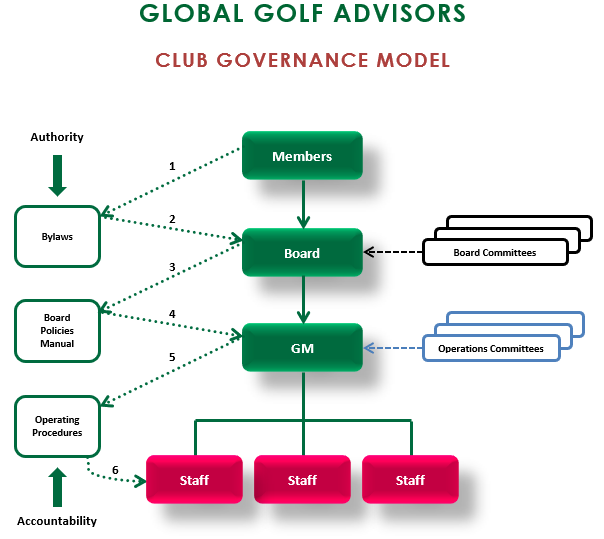The Club Governance Model (Model), which was developed in 2007 and updated in 2018, is built upon accepted principles and best practices in nonprofit governance. Although this Model is directed primarily toward member-owned clubs, the principles embodied in the Model are no less applicable to clubs with a different ownership structure. The primary purpose of the Model is to optimize the most fundamental quality of a governance system – the smooth flow of authority from the club owners to the club staff and the corresponding flow of accountability from the staff back to the club owners. The Model, as shown in the flow chart below, is simply a set of principles designed to keep communications throughout the organization clear and the roles of key participants unambiguous.
The extent of the changes required of a club to implement the Model will depend on the governance system that it presently employs. However, the ease of implementing the Model will depend less on the number and extent of changes needed and more on the commitment of the club’s leaders, namely, the President, the Club General Manager/Chief Operating Officer (GM/COO), and the Board members. A club that is considering the Model for its governance structure and processes must not only assess the necessary steps in moving to the Model, but it must also measure the resolve of its leaders to follow through on the implementation. The caution to be followed here is “don’t start the process unless you have the commitment to finish it.”
Implementing the Model will usually involve amending the bylaws, although the changes recommended are usually straightforward and non-disruptive. The implementation step that will call on the greatest effort, and therefore commitment, is the development and eventual employment of a Board Policies Manual (BPM). From the time that the Board approves the initial version of its BPM, this important document can serve as a governance management system that provides a clear-cut path to success. As with any good system that is utilized on an on-going basis, the BPM will be continually modified and refined to respond to a changing environment. As the Board rely more and more on the BPM to be its single and clear voice, it will reinforce the underlying principles of the Model and allow the club to accrue the substantial benefits of an efficient and effective system of governance.
Overarching – From a high-level perspective, boards are meant to only serve a strategic role whereby their main function is safeguarding assets and evaluating and developing long-term strategic options. The role of management is to operate the club, while committees are meant to only serve an advisory function, with no authoritative or executive powers.
Board Members – Board members are, of course, club members. As such, they are customers, and volunteers. Board members are also trustees or governors in that they are elected to govern the affairs of the club subject to limitations that may be set out in the bylaws. But Board members have the authority to govern (i.e., are “governors”) only when they are taking part in an official Board meeting. Even though Board members are often active in committee meetings or efforts to assist the GM and his or her staff, when Board members are not in an official Board meeting, they are serving as volunteers and not governors.
Club Officers – Club officers, typically the President, Vice-President, Secretary, and Treasurer, are normally Board members with special responsibilities in addition to their duties as Board members. They are usually elected by the Board and subject to the Board’s authority and direction. As such, they have the authority only when it is granted by the bylaws or the Board. This means that the President does not represent a separate level of authority and does not supervise the GM except as specifically authorized to do so in the Board Policies Manual. The President is almost always the Chair of the Board and is responsible for maintaining the integrity of the governance structure and related processes. He or she normally is the chief representative of the members and the spokesperson for the Board. As Chair of the Board, he or she sets the agenda of Board meetings and ensures that the Board stays at an appropriate level with its thinking, discussions, and policy development. The President is often an ex officio member of all committees. Therefore, he can serve both in a coordinating role among the Board Committees and in a leadership role in keeping them focused on their respective scopes of responsibility. The duties of other officers are not discussed here because they have less to do with the governance structure and processes.
Committees – As shown in Exhibit I, the Model contains two types of committees. The Board Committees support the Board in Board-level functions (e.g., Governance, Finance, and Programs) while the Operations Committees (e.g., Golf Committee, Green Committee, Tennis Committee, Food & Beverage) support the GM. Board Committees study issues and recommend policies that support decisions at the Board or strategic levels. Operations Committees serve the GM by offering critical member (customer) input and in sharing the workload by helping with events and activities. As critical as the committees are in supporting both the Board and GM, they serve in an advisory capacity, not from a position of authority.
General Manager – The GM is the single agent of the Board with responsibility to carry out the purpose of the club within the policy boundaries set by the Board. Therefore, he or she has operational authority to employ and allocate the resources of the club to serve its members so long as he stays within the boundaries set by the Board in the Board Policies Manual.
Click here to download or save this article.
This article was authored by George Pinches, a Director at Global Golf Advisors, who specializes in Club Governance. Reach him at gpinches@globalgolfadvisors.com.



